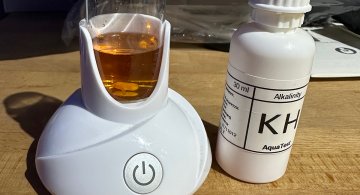Getting Nitrates Under Control
The good news is... They Can Be Beaten Down Into Submission.
Nitrates are a part of nature in the ocean, and correspondingly in our tanks. As waste breaks down in your aquarium, it cycles from ammonia to nitrite to nitrates. The first two are highly toxic to marine life, and we make it a point to make sure our tanks test zero for these. However, nitrates aren’t as bad, and sometimes are even a little beneficial.
Specifically, few organisms need nitrates. Both micro and macro algae love the stuff, while fish tolerate it. Invertebrates suffer if the levels are too high, but a little is required to keep clams happy. In our goal to match NSW as closely as possible, we strive to keep nitrates down to a minimum at 10 ppm or less.
First things first -- what is causing the nitrates in your tank? Bioballs, biowheels, filter pads, foam blocks & tubes, and under gravel filters all contribute to the production of nitrates. Overfeeding is another cause, and a lack of water changes will be another factor.
Nitrates are in the water column, not your substrate or rockwork. Frequent large water changes will quickly reduce the amounts of nitrates present in your system. I battled with nitrates for years, even when using Nitrate Sponge on a weekly basis. I’d change 5 gallons in my 29 gallon tank and see the nitrates drop from 80 to 60ppm, only to rise again. I’d cringe when I’d run a new test and see the fluid bright red before the timer was even set!
Once I removed the 3 year-old under gravel filter & my Penguin Biowheel filter filled with bioballs, I was finally on track. I did three 10 gallon water changes in one week, or 33% at a time. Nitrates were down to 20ppm. I became more meticulous with my water changes, changing 7 - 10 gallons each time every two weeks.
Later on that year, I added a sump & refugium to that tank. The saying “Dilution is the Solution to Pollution” proved to be absolutely true. The macro algae in the refugium as well as the small sandbed helped denitrify my tank, and nitrates are ranging from 0 - 2ppm with a water change only being done every other month.
In November 2002, I bought an existing 55 gallon tank filled with seven fish, 120 lbs of live rock and crushed coral substrate. The previous owners never tested their water, and the nitrates were 200ppm or more. Through a series of major water changes in those first two weeks, nitrates were lowered without stressing the fish. The substrate was replaced with a DSB (deep sand bed), and the canister filters with biowheels were removed as a sump was incorporated. Nitrates were down to 7ppm after three months, and only one fish was lost during that period (probably due to starvation… it never looked healthy).
If your tank is suffering from high nitrate levels, the success of your reef will depend on your being able to get this under control. Changing 100% of the water would be the ideal, but it may shock your corals, fish and invertebrates in the process. A more gradual way is recommended.
Example from my 55-gallon Reef : Make up 20 gallons of fresh saltwater in a trashcan in front of your tank. Drain 10 gallons of tank water into the 20 gallons of new water, and let that mix. Pump 10 gallons of that water back into your tank, and let the power heads mix that water up in your tank for a minute or so. Then repeat this three more times. Dispose of the now polluted 20 gallons of water. Make up another 20 gallons of fresh saltwater, and repeat this procedure. As long as your temperature and salinity match the tank, your inhabitants won’t be affected adversely, and with each rotation of water, the nitrates are being diluted and removed from your tank.
Simply pulling out all of the water in one massive water change puts stress on your entire tank. Doing small water changes consistently won’t bring nitrate levels down. At best, it will maintain them at their current levels. Using the example above, a tank that was at 80ppm would be around 30ppm after a couple of hours work and your population will be happy and unaffected. Once your nitrate levels drop, they are easily kept low with regular water changes, as well as the use of a DSB and macro algae.
Your tank will be healthier, your reef happier and the nitrate problem fixed!
Update - 5/10/09:
Since the writing of this article six years ago, other options have become available. Some people have opted to purchase a De-nitrification Reactor, such as the one made by Midwest Systems. These definitely work, but they are not cheap.
Another method that has proven effective is to dose the tank with a carbon source, such as vodka, sugar, or vinegar. Some use a combination of these three products, concocting a very precise dosing regiment. Please do your homework before putting anything new in your tank. I've been dosing my 280g reef tank with vodka since July 2008, and will be doing a write up soon on what that entailed and how it worked. In the meantime, here's the article that was my guide. Please read it very carefully: Notes from the Trenches - Vodka Dosing... Distilled!
Update - 5/11/09:
Was that soon enough? LOL Here's the article: Vodka Dosing - Why?
Update - 6/3/11:
Now I'm using biopellets. And it's working great so far.
Update - 9/30/14:
I stopped running biopellets and am only using Prodibio after waiting about 3 months for the corals to settle down after an accidental overdosing event. I did a few water changes and waited 12 weeks, the resumed Prodibio dosing every 15 days.
Another nitrate reduction method that has worked for some is NoPox by RedSea which is great for smaller system, but has to be dosed daily.
Update - 1/28/16:
Using biopellets once more to get nitrates back down as they rose inexplicably high in record time over the holidays.
Update - 11/30/16:
Nitrate has measured less than 2ppm for over six months. Here's my video pertaining to important biopellet knowledge after years of personal experience:
And I'm using the Elos Nitrate test kit these days. API is just fine if you want to go that route, but Elos measures between 0 and 25ppm with a very easy to determine color chart.

















